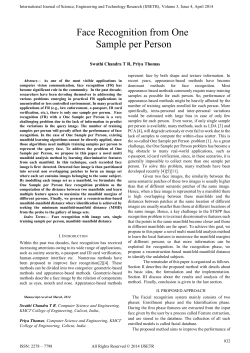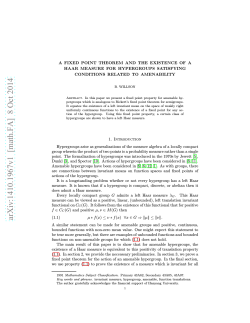
Two reliable approaches involving Haar wavelet method
Two reliable approaches involving Haar wavelet method and Optimal Homotopy Asymptotic method for the solution of fractional Fisher type equation Santanu Saha Ray National Institute of Technology Rourkela, Department of Mathematics, Rourkela-769008, Orissa, India E-mail: santanusaharay@yahoo.com, saharays@nitrkl.ac.in Abstract. In this article, two reliable techniques, Haar wavelet method and optimal homotopy asymptotic method (OHAM) are presented. Haar wavelet method is an efficient numerical method for the numerical solution of fractional order partial differential equation like Fisher type. The approximate solutions of the fractional Fisher type equation are compared with the optimal homotopy asymptotic method as well as with the exact solutions. Comparisons between the obtained solutions with the exact solutions exhibit that both the featured methods are effective and efficient in solving nonlinear problems. However, the results indicate that OHAM provides more accurate value than Haar wavelet method. 1. Introduction Fractional calculus is a field of applied mathematics which deals with derivatives and integrals of arbitrary orders [1, 2]. In the last few decades, fractional calculus has been extensively investigated due to their broad applications in mathematics, physics and engineering such as viscoelasticity, diffusion of biological population, signal processing, electromagnetism, fluid mechanics, electrochemistry and so on. For this we need a reliable and efficient technique for the solution of fractional differential equations. Wavelet theory is a relatively new and an emerging area in mathematical research. Approximation by orthogonal wavelets bases are becoming more popular for numerical solutions of fractional differential equations due to their excellent properties such as ability to detect singularities, orthogonality, flexibility to represent a function at different level of resolution and compact support. One of the pretty feature of wavelets is its ability to convert the given differential and integral equations to a system of linear or nonlinear differential equations, which can be solved by numerical methods. The generalized time-fractional Fisher’s biological population diffusion equation is given by ∂ α u ∂ 2u = 2 + F (u) , u (x, 0) = φ (x) ∂t α ∂x (1.1) where u (x,t) denotes the population density and t > 0, x ∈ R, F(u) is a continuous nonlinear function satisfying the following conditions F (0) = F (1) = 0, F 0 (0) > 0 > F 0 (1). The derivative in eq. (1.1) is the Caputo derivative of order α. Definition: The fractional derivative introduced by Caputo [1], in the late sixties, is called Caputo Fractional derivative. The Caputo fractional derivative 0 Dtα of a function f (t) is defined as [1] α 0 Dt 1 f (t) = Γ (n − α) Z t f n (τ) 0 (t − τ)α−n+1 dτ, (n − 1 < α ≤ n, n ∈ N) (1.2) The notion of L2 error in Haar wavelet method as well as in case of OHAM, the fine tuning of convergence region by using optimal values of convergence control parameters justify that both the methods are reliable. Our aim in the present work is to implement Haar wavelet method and optimal homotopy asymptotic method (OHAM) in order to demonstrate the capability of these methods in handling nonlinear equations of arbitrary order, so that one can apply it to various types of nonlinearity. 2. Function Approximation Any function y(t) ∈ L2 ([0, 1)) can be expanded into Haar wavelets by [3–5] y(t) = c0 h0 (t) + c1 h1 (t) + c2 h2 (t) + ... (2.1) R1 where c j = 0 y(t)h j (t)dt. If y(t) is approximated as piecewise constant in each subinterval, the sum in eq. (2.1) may be terminated after m terms and consequently we can write discrete version in the matrix form as m−1 Y≈ ∑ ci hi (tl ) = CmT .Hm , (2.2) i=0 where Y and CmT are the m-dimensional row vectors. Here H is the Haar wavelet matrix of order m defined by H = [h0 , h1 , ..., hm−1 ]T , h0 , h1 , ..., hm−1 are the discrete form of the Haar wavelet bases. The collocation points are given by tl = A + (l − 0.5) ∆t, l = 1, 2, ..., m. 3. Operational matrix of the general order integration The integration of Hm (t) = [h0 (t) , h1 (t) , ..., hm−1 (t)]T can be approximated by [5] Z t 0 Hm (τ) dτ ∼ = QHm (t) , (3.1) where Q is called the Haar wavelet operational matrix of integration which is a square matrix of m−dimension. The Haar wavelet operational matrix Qα for integration of the general order α is given by Qα Hm (t) = J α Hm (t) = [J α h0 (t) , J α h1 (t) , ..., J α hm−1 (t)]T = [Qh0 (t) , Qh1 (t) , ..., Qhm−1 (t)]T where ( Qh0 (t) = tα Γ(1+α) , t ∈ [A, B] 0, elsewhere, and 0, φ , 1 Qhi (t) = φ2 , φ3 , A ≤ t < ζ1 (i) ζ1 (i) ≤ t < ζ2 (i) ζ2 (i) ≤ t < ζ3 (i) ζ3 (i) ≤ t < B, (3.2) (3.3) where φ1 = (t − ζ1 (i))α (t − ζ1 (i))α (t − ζ2 (i))α (t − ζ1 (i))α (t − ζ2 (i))α (t − ζ3 (i))α , φ2 = −2 , φ3 = −2 + Γ (α + 1) Γ (α + 1) Γ (α + 1) Γ (α + 1) Γ (α + 1) Γ (α + 1) for i = 1, 2, ..., m, m = 2J and J is a positive integer, called the maximum level of resolution. Here j and k represent the integer decomposition of the index i. i.e. i = k + 2 j − 1 and 1 ≤ k < 2 j + 1. 4. Application of Haar wavelet to Fractional Fisher type Equation Consider the nonlinear diffusion equation of the fractional Fisher type [6, 7] ∂ α u ∂ 2u = 2 + u (1 − u) (u − a) , ∂t α ∂x 0 < α ≤ 1, with the initial condition 0 ≤ x ≤ 1, 0<a<1 1 u(x, 0) = 1 + exp −x √ 2 (4.1) (4.2) When α = 1, the exact solution of eq. (4.1) is given by [8, 9] u(x,t) = 1 h i ; √ 1 + exp − x+ct 2 √ 1 −a 2 2 c= (4.3) Let us divide both space and time interval [0, 1] into m equal subintervals; each of width ∆ = m1 . 2 Haar wavelet solution of u(x,t) is sought by assuming that ∂ ∂u(x,t) can be expanded in terms of Haar x2 wavelets as m m ∂ 2 u(x,t) = (4.4) ∑ ∑ ci j hi (x)h j (t) ∂ x2 i=1 j=1 Integrating eq. (4.4) twice w.r.t. x from 0 to x we get m m u(x,t) = ∑ ∑ ci j Q2 hi (x)h j (t) + q(t) + xp(t) (4.5) i=1 j=1 Again q(t) + xp(t) can be approximated using Haar wavelet function as m m q(t) + xp(t) = ∑ ∑ ri j hi (x)h j (t) (4.6) i=1 j=1 Substituting eq. (4.6) in eq. (4.5) we get m m m m u(x,t) = ∑ ∑ ci j Q2 hi (x)h j (t) + ∑ ∑ ri j hi (x)h j (t) i=1 j=1 (4.7) i=1 j=1 The nonlinear term presented in eq. (4.1) can be approximated using Haar wavelet function as m m u(1 − u)(u − a) = ∑ ∑ di j hi (x)h j (t) (4.8) i=1 j=1 Therefore, m m m ! m 2 ∑ ∑ ci j Q hi (x)h j (t) + ∑ ∑ ri j hi (x)h j (t) i=1 j=1 m i=1 j=1 m m m i=1 j=1 m ! 1 − ∑ ∑ ci j Q hi (x)h j (t) + ∑ ∑ ri j hi (x)h j (t) i=1 j=1 ∑ ∑ ci j Q2 hi (x)h j (t) + ∑ ∑ ri j hi (x)h j (t) − a i=1 j=1 m 2 ! m m m i=1 j=1 m = ∑ ∑ di j hi (x)h j (t) (4.9) i=1 j=1 Substituting eqs. (4.4) and (4.8) in eq. (4.1) and applying J α to both sides, we will have " # " # m u(x,t) − u(x, 0) = Jtα m ∑ ∑ ci j hi (x)h j (t) i=1 j=1 m + Jtα m ∑ ∑ di j hi (x)h j (t) i=1 j=1 (4.10) Substituting eqs. (4.2) and (4.7) in eq. (4.9) we get m m m m ∑ ∑ ci j Q2 hi (x)h j (t) + ∑ ∑ ri j hi (x)h j (t) − i=1 j=1 i=1 j=1 m 1 1 + exp −x √ 2 m = ∑ ∑ ci j hi (x)Qtα h j (t) i=1 j=1 m m + ∑ ∑ di j hi (x)Qtα h j (t) (4.11) i=1 j=1 k−0.5 Now substituting the collocation points xl = l−0.5 m and tk = m for l, k = 1, 2, ..., m in eqs. (4.6), (4.9) and (4.11), we have 3m2 equations in 3m2 unknowns in ci j , ri j and di j . By solving these system of equations using mathematical software, the Haar wavelet coefficients ci j , ri j and di j can be obtained. 5. Application of OHAM to Fractional Fisher type Equation The OHAM was introduced and developed by Merinca et al. [10]. In OHAM, the control and adjustment of the convergence region are provided in a convenient way. We construct a homotopy ϕ(x,t; p) : Ω × [0, 1] −→ R for eq. (4.1) which is given by α ∂ ϕ(x,t; p) ∂ 2 ϕ(x,t; p) ∂ α ϕ(x,t; p) = H(p) − − ϕ(x,t; p) [1 − ϕ(x,t; p)] [ϕ(x,t; p) − a] (1 − p) ∂t α ∂t α ∂ x2 (5.1) where p ∈ [0, 1] is an embedding parameter, H(p) is a nonzero auxiliary function for p 6= 0 and H(0) = 0. When p = 0 and p = 1, we have ϕ(x,t; 0) = u0 (x,t) and ϕ(x,t; 1) = u(x,t), respectively. Thus as p varies from 0 to 1, the solution ϕ(x,t; p) approaches from u0 (x,t) to u(x,t). Here ∞ ϕ(x,t; p) = u0 (x,t) + ∑ ui (x,t)pi (5.2) H(p) = pC1 + p2C2 + p3C3 + ... (5.3) i=1 ∞ N (ϕ(x,t; p)) = N0 (u0 (x,t)) + ∑ Nk (u0 , u1 , ..., uk ) pk (5.4) k=1 Substituting eqs. (5.2), (5.3) and (5.4) in eq. (5.1) and equating the coefficients of like powers of p and again solving those equations, we obtain the second order approximate solution using the following formula u(x,t) = u0 (x,t) + u1 (x,t) + u2 (x,t) (5.5) The optimal values of the convergence control constants C1 and C2 can be obtained using collocation method. Substituting in eq. (4.1), we get the following expression for the residual Rn (x,t;C1 ,C2 ,C3 , ...). If Rn (x,t;C1 ,C2 ,C3 , ...) = 0, then u˜ (x,t;C1 ,C2 ,C3 , ...) is the exact solution. Generally such case does not arise for nonlinear problems. The convergence of the n−th approximate solution depends upon unknown constants C1 ,C2 ,C3 , .... When the convergence control constants C1 ,C2 ,C3 , ... are known by the above mentioned methods then the approximate solution of (4.1) is well determined. 6. Numerical results and discussion The following Table 1 shows the comparison of the approximate solutions of fractional Fisher type equation (4.1) obtained by using Haar wavelet method and OHAM at different values of x and t taking α = 0.5. The following Table 2 exhibits the L2 and L∞ error norm for fractional Fisher type equation at different values of t and α = 1. It can be easily observed from Table 2 that the solutions obtained by OHAM are more accurate than that of Haar wavelet method. Table 1. The approximate solutions of fractional Fisher type equation (4.1) using Haar wavelet method and three terms for second order OHAM at various points of x and t taking α = 0.5 x 0.1 0.3 0.5 0.7 0.9 t = 0.2 uHaar uOHAM 0.531396 0.55521 0.557098 0.589616 0.586931 0.623164 0.613502 0.655571 0.643461 0.686593 t = 0.4 uHaar uOHAM 0.550389 0.570645 0.582811 0.604511 0.617982 0.637394 0.644668 0.669033 0.669891 0.699213 t = 0.6 uHaar uOHAM 0.570167 0.582442 0.607055 0.615806 0.645433 0.648094 0.671439 0.679069 0.69255 0.708537 t = 0.8 uHaar uOHAM 0.586081 0.592358 0.625465 0.625237 0.665485 0.656966 0.690761 0.68733 0.709084 0.68733 Table 2. L2 and L∞ error norm for Fisher type equation t. Time(sec) 0.2 0.4 0.6 0.8 HWM L2 L∞ 0.0377811 0.0489923 0.00380168 0.00797543 0.020685 0.0293499 0.0281228 0.0394803 OHAM L2 L∞ 1.50470E-5 2.47294E-5 5.05627E-5 8.90920E-5 9.97048E-5 1.79900E-4 1.69576E-4 2.85670E-4 7. Conclusion In this paper, the classical as well as fractional Fisher type equation has been solved by using Haar wavelet method. The obtained results are then compared with exact solutions as well as with relatively new optimal homotopy asymptotic method (OHAM). These results have been cited in the tables demonstrated in order to justify the accuracy and efficiency of the proposed schemes. The Haar wavelet technique provides quite satisfactory results for the fractional Fisher type equation (4.1). The main advantages of this Haar wavelet method is they transfer the whole scheme into a system of algebraic equations for which the computation is easy and simple. OHAM allows fine tuning of convergence region and rate of convergence by suitably identifying convergence control parameters C1 ,C2 ,C3 , .... The results obtained by OHAM are more accurate as its convergence region can be easily adjusted and controlled. The main advantages of these schemes are their simplicity, applicability and less computational errors. Although the obtained results indicate that optimal homotopy asymptotic method provides more accurate value than Haar wavelet method, however the accuracy of the wavelet method may be improved with the increase of level of resolution. Comparison shows that these two methods are reliable, appropriate and applicable for solving nonlinear fractional Fisher’s equation. References [1] Podlubny I 1999 Fractional Differential Equations (New York: Academic Press) [2] Hilfer R 2000 Applications of fractional calculus in physics (Singapore: World Scientific) [3] Saha Ray S 2012 Appl. Math. Comput. 218 5239–48 [4] Saha Ray S and Patra A 2013 Appl. Math. Comput. 220 659–67 [5] Chen C F and Hsiao C H 1997 IEE Proc-Control Theory Appication 144(1) 87-94 [6] Wazwaz A M 2009 Partial Differential equations and Solitary Waves Theory (Berlin: Springer) [7] Fisher R A 1937 Ann. Eugen. 7(4) 355–69 [8] Liu Y 2011 Journal of Fractional Calculus and Applications 1(2) 1-8 [9] Wazwaz A M and Gorguis A 2004 Appl. Math. Comput. 154 609–20 [10] Marinca V, Herisanu N, Bota C and Marinca B 2009 Appl. Math. Lett. 22(2) 245–51
© Copyright 2025

















